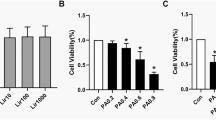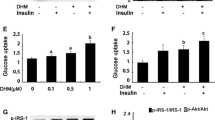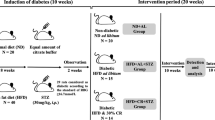Abstract
Impairment of insulin signaling in skeletal muscle detrimentally affects insulin-stimulated disposal of glucose. Restoration of insulin signaling in skeletal muscle is important as muscle is one of the major sites for disposal of blood glucose. Recently, unacylated ghrelin (UnAG) has received attention in diabetic research due to its favorable actions on improving glucose tolerance, glycemic control, and insulin sensitivity. The investigation of UnAG has entered phase Ib clinical trial in type 2 diabetes and phase II clinical trial in hyperphagia in Prader-Willi syndrome. Nonetheless, the precise mechanisms responsible for the anti-diabetic actions of UnAG remain incompletely understood. In this study, we examined the effects of UnAG on restoring the impaired insulin signaling in skeletal muscle of db/db diabetic mice. Our results demonstrated that UnAG effectively restored the impaired insulin signaling in diabetic muscle. UnAG decreased insulin receptor substrate (IRS) phosphorylation, increased protein kinase B (Akt) phosphorylation, and, hence, suppressed mTOR signaling. Consequently, UnAG enhanced Glut4 localization and increased PDH activity in the diabetic skeletal muscle. Intriguingly, our data indicated that UnAG normalized the suppressed autophagic signaling in diabetic muscle. In conclusion, our findings illustrated that UnAG restored the impaired insulin and autophagic signaling in skeletal muscle of diabetic mice, which are valuable to understand the underlying mechanisms of the anti-diabetic action of UnAG at peripheral skeletal muscle level.





Similar content being viewed by others
Abbreviations
- 4-HNE:
-
4-Hydroxynonenal
- AG:
-
Acylated ghrelin
- Akt:
-
Protein kinase B
- AS160:
-
Akt substrate of 160 kDa
- AMPKα:
-
AMP-activated protein kinase alpha
- UnAG:
-
Unacylated ghrelin
- db/+:
-
Non-diabetic group
- db/db :
-
Diabetic group
- Glut 4:
-
Glucose transporter type 4
- IMCL:
-
Intramyocellular lipid
- IR:
-
Insulin receptor
- IRS:
-
Insulin receptor substrate
- LC3:
-
Microtubule-associated protein 1 light chain 3
- MAPK:
-
Ras-mitogen-activated protein kinase
- mTOR:
-
Mammalian target of rapamycin
- mTORC1:
-
Mammalian target of rapamycin complex 1
- munc18:
-
Mammalian uncoordinated-18
- p62:
-
Sequestosome 1
- PBS:
-
Phosphate-buffered saline
- PDH:
-
Pyruvate dehydrogenase
- PDK1:
-
3-phosphoinositide-dependent protein kinase 1
- PI3K:
-
Phosphatidylinositol 3-kinase
- PKCλ/ζ:
-
Atypical protein kinase C
- RALA:
-
Ras-related protein Ral-A
- RLG:
-
Right lateral gastrocnemius
- Ulk1:
-
Unc-51 like autophagy activating kinase 1
- VAMP-2:
-
Vesicle-associated membrane protein 2
References
Aguirre V, Uchida T, Yenush L, Davis R, White MF (2000) The c-Jun NH(2)-terminal kinase promotes insulin resistance during association with insulin receptor substrate-1 and phosphorylation of Ser(307). J Biol Chem 275(12):9047–9054
Aguirre V, Werner ED, Giraud J, Lee YH, Shoelson SE, White MF (2002) Phosphorylation of Ser307 in insulin receptor substrate-1 blocks interactions with the insulin receptor and inhibits insulin action. J Biol Chem 277(2):1531–1537. doi:10.1074/jbc.M101521200
Andersen H, Gadeberg PC, Brock B, Jakobsen J (1997) Muscular atrophy in diabetic neuropathy: a stereological magnetic resonance imaging study. Diabetologia 40(9):1062–1069. doi:10.1007/s001250050788
Asakawa A, Inui A, Fujimiya M, Sakamaki R, Shinfuku N, Ueta Y, Meguid MM, Kasuga M (2005) Stomach regulates energy balance via acylated ghrelin and desacyl ghrelin. Gut 54(1):18–24. doi:10.1136/gut.2004.038737
Attaix D, Combaret L, Bechet D, Taillandier D (2008) Role of the ubiquitin-proteasome pathway in muscle atrophy in cachexia. Curr Opin Support Palliative Care 2(4):262–266
Avruch J (1998) Insulin signal transduction through protein kinase cascades. Mol Cell Biochem 182(1–2):31–48
Bandyopadhyay GK, Yu JG, Ofrecio J, Olefsky JM (2005) Increased p85/55/50 expression and decreased phosphotidylinositol 3-kinase activity in insulin-resistant human skeletal muscle. Diabetes 54(8):2351–2359
Cederberg H, Rajala U, Koivisto VM, Jokelainen J, Surcel HM, Keinanen-Kiukaanniemi S, Laakso M (2011) Unacylated ghrelin is associated with changes in body composition and body fat distribution during long-term exercise intervention. Eur J Endocrinol 165(2):243–248. doi:10.1530/EJE-11-0334
Chamoux E, McManus S, Laberge G, Bisson M, Roux S (2013) Involvement of kinase PKC-zeta in the p62/p62(P392L)-driven activation of NF-kappaB in human osteoclasts. Biochim Biophys Acta 1832(3):475–484. doi:10.1016/j.bbadis.2012.12.008
Chen XW, Leto D, Xiao J, Goss J, Wang Q, Shavit JA, Xiong T, Yu G, Ginsburg D, Toomre D, Xu Z, Saltiel AR (2011) Exocyst function is regulated by effector phosphorylation. Nat Cell Biol 13(5):580–588. doi:10.1038/ncb2226
Chen XW, Leto D, Xiong T, Yu G, Cheng A, Decker S, Saltiel AR (2011) A Ral GAP complex links PI 3-kinase/Akt signaling to RalA activation in insulin action. Mol Biol Cell 22(1):141–152. doi:10.1091/mbc.E10-08-0665
Constantin-Teodosiu D (2013) Regulation of muscle pyruvate dehydrogenase complex in insulin resistance: effects of exercise and dichloroacetate. Diabetes Metab J 37(5):301–314. doi:10.4093/dmj.2013.37.5.301
Cuzzocrea S, Pisano B, Dugo L, Ianaro A, Maffia P, Patel NS, Di Paola R, Ialenti A, Genovese T, Chatterjee PK, Di Rosa M, Caputi AP, Thiemermann C (2004) Rosiglitazone, a ligand of the peroxisome proliferator-activated receptor-gamma, reduces acute inflammation. Eur J Pharmacol 483(1):79–93
DeFronzo RA, Tripathy D (2009) Skeletal muscle insulin resistance is the primary defect in type 2 diabetes. Diabetes Care 32(Suppl 2):S157–S163. doi:10.2337/dc09-S302
Delhanty PJ, Neggers SJ, van der Lely AJ (2012) Mechanisms in endocrinology: ghrelin: the differences between acyl- and des-acyl ghrelin. Eur J Endocrinol 167(5):601–608. doi:10.1530/EJE-12-0456
Delhanty PJ, Sun Y, Visser JA, van Kerkwijk A, Huisman M, van Ijcken WF, Swagemakers S, Smith RG, Themmen AP, van der Lely AJ (2010) Unacylated ghrelin rapidly modulates lipogenic and insulin signaling pathway gene expression in metabolically active tissues of GHSR deleted mice. PLoS One 5(7):e11749. doi:10.1371/journal.pone.0011749
Duran A, Serrano M, Leitges M, Flores JM, Picard S, Brown JP, Moscat J, Diaz-Meco MT (2004) The atypical PKC-interacting protein p62 is an important mediator of RANK-activated osteoclastogenesis. Dev Cell 6(2):303–309
Ferrannini E, Simonson DC, Katz LD, Reichard G Jr, Bevilacqua S, Barrett EJ, Olsson M, DeFronzo RA (1988) The disposal of an oral glucose load in patients with non-insulin-dependent diabetes. Metabolism 37(1):79–85
Fujitani Y, Kawamori R, Watada H (2009) The role of autophagy in pancreatic beta-cell and diabetes. Autophagy 5(2):280–282
Gomes-Marcondes MC, Tisdale MJ (2002) Induction of protein catabolism and the ubiquitin-proteasome pathway by mild oxidative stress. Cancer Lett 180(1):69–74
Granata R, Settanni F, Biancone L, Trovato L, Nano R, Bertuzzi F, Destefanis S, Annunziata M, Martinetti M, Catapano F, Ghe C, Isgaard J, Papotti M, Ghigo E, Muccioli G (2007) Acylated and unacylated ghrelin promote proliferation and inhibit apoptosis of pancreatic beta-cells and human islets: involvement of 3′,5′-cyclic adenosine monophosphate/protein kinase A, extracellular signal-regulated kinase 1/2, and phosphatidyl inositol 3-Kinase/Akt signaling. Endocrinology 148(2):512–529. doi:10.1210/en.2006-0266
Granata R, Settanni F, Julien M, Nano R, Togliatto G, Trombetta A, Gallo D, Piemonti L, Brizzi MF, Abribat T, van Der Lely AJ, Ghigo E (2012) Des-acyl ghrelin fragments and analogues promote survival of pancreatic beta-cells and human pancreatic islets and prevent diabetes in streptozotocin-treated rats. J Med Chem 55(6):2585–2596. doi:10.1021/jm201223m
Hancer NJ, Qiu W, Cherella C, Li Y, Copps KD, White MF (2014) Insulin and metabolic stress stimulate multisite serine/threonine phosphorylation of insulin receptor substrate 1 and inhibit tyrosine phosphorylation. J Biol Chem 289(18):12467–12484. doi:10.1074/jbc.M114.554162
He C, Bassik MC, Moresi V, Sun K, Wei Y, Zou Z, An Z, Loh J, Fisher J, Sun Q, Korsmeyer S, Packer M, May HI, Hill JA, Virgin HW, Gilpin C, Xiao G, Bassel-Duby R, Scherer PE, Levine B (2012) Exercise-induced BCL2-regulated autophagy is required for muscle glucose homeostasis. Nature 481(7382):511–515. doi:10.1038/nature10758
Hodgkinson CP, Mander A, Sale GJ (2005) Protein kinase-zeta interacts with munc18c: role in GLUT4 trafficking. Diabetologia 48(8):1627–1636. doi:10.1007/s00125-005-1819-y
Huang HC, Huang CY, Lin-Shiau SY, Lin JK (2009) Ursolic acid inhibits IL-1beta or TNF-alpha-induced C6 glioma invasion through suppressing the association ZIP/p62 with PKC-zeta and downregulating the MMP-9 expression. Mol Carcinog 48(6):517–531. doi:10.1002/mc.20490
Kim KH, Jeong YT, Oh H, Kim SH, Cho JM, Kim YN, Kim SS, Kim Do H, Hur KY, Kim HK, Ko T, Han J, Kim HL, Kim J, Back SH, Komatsu M, Chen H, Chan DC, Konishi M, Itoh N, Choi CS, Lee MS (2013) Autophagy deficiency leads to protection from obesity and insulin resistance by inducing Fgf21 as a mitokine. Nat Med 19(1):83–92. doi:10.1038/nm.3014
Kwon G, Xu G, Marshall CA, McDaniel ML (1999) Tumor necrosis factor alpha-induced pancreatic beta-cell insulin resistance is mediated by nitric oxide and prevented by 15-deoxy-Delta12,14-prostaglandin J2 and aminoguanidine. A role for peroxisome proliferator-activated receptor gamma activation and inos expression. J Biol Chem 274(26):18702–18708
Lansey MN, Walker NN, Hargett SR, Stevens JR, Keller SR (2012) Deletion of Rab GAP AS160 modifies glucose uptake and GLUT4 translocation in primary skeletal muscles and adipocytes and impairs glucose homeostasis. Am J Physiol Endocrinol Metab 303(10):E1273–E1286. doi:10.1152/ajpendo.00316.2012
Le Marchand-Brustel Y, Gual P, Gremeaux T, Gonzalez T, Barres R, Tanti JF (2003) Fatty acid-induced insulin resistance: role of insulin receptor substrate 1 serine phosphorylation in the retroregulation of insulin signalling. Biochem Soc Trans 31(Pt 6):1152–1156. doi:10.1042/bst0311152
Leto D, Saltiel AR (2012) Regulation of glucose transport by insulin: traffic control of GLUT4. Nat Rev Mol Cell Biol 13(6):383–396. doi:10.1038/nrm3351
Li L, Zhang LK, Pang YZ, Pan CS, Qi YF, Chen L, Wang X, Tang CS, Zhang J (2006) Cardioprotective effects of ghrelin and des-octanoyl ghrelin on myocardial injury induced by isoproterenol in rats. Acta Pharmacol Sin 27(5):527–535. doi:10.1111/j.1745-7254.2006.00319.x
Lv P, Huang J, Yang J, Deng Y, Xu J, Zhang X, Li W, Zhang H, Yang Y (2014) Autophagy in muscle of glucose-infusion hyperglycemia rats and streptozotocin-induced hyperglycemia rats via selective activation of m-TOR or FoxO3. PLoS One 9(2):e87254. doi:10.1371/journal.pone.0087254
Martins AR, Nachbar RT, Gorjao R, Vinolo MA, Festuccia WT, Lambertucci RH, Cury-Boaventura MF, Silveira LR, Curi R, Hirabara SM (2012) Mechanisms underlying skeletal muscle insulin resistance induced by fatty acids: importance of the mitochondrial function. Lipids Health Dis 11:30. doi:10.1186/1476-511X-11-30
Masiero E, Sandri M (2010) Autophagy inhibition induces atrophy and myopathy in adult skeletal muscles. Autophagy 6(2):307–309
Mayers RM, Leighton B, Kilgour E (2005) PDH kinase inhibitors: a novel therapy for type II diabetes? Biochem Soc Trans 33(Pt 2):367–370. doi:10.1042/BST0330367
Mizushima N, Yoshimori T (2007) How to interpret LC3 immunoblotting. Autophagy 3(6):542–545
Morino K, Petersen KF, Dufour S, Befroy D, Frattini J, Shatzkes N, Neschen S, White MF, Bilz S, Sono S, Pypaert M, Shulman GI (2005) Reduced mitochondrial density and increased IRS-1 serine phosphorylation in muscle of insulin-resistant offspring of type 2 diabetic parents. J Clin Invest 115(12):3587–3593. doi:10.1172/JCI25151
Murrow L, Debnath J (2013) Autophagy as a stress-response and quality-control mechanism: implications for cell injury and human disease. Annu Rev Pathol 8:105–137. doi:10.1146/annurev-pathol-020712-163918
Nagaya N, Uematsu M, Kojima M, Ikeda Y, Yoshihara F, Shimizu W, Hosoda H, Hirota Y, Ishida H, Mori H, Kangawa K (2001) Chronic administration of ghrelin improves left ventricular dysfunction and attenuates development of cardiac cachexia in rats with heart failure. Circulation 104(12):1430–1435
Nascimento EB, Fodor M, van der Zon GC, Jazet IM, Meinders AE, Voshol PJ, Vlasblom R, Baan B, Eckel J, Maassen JA, Diamant M, Ouwens DM (2006) Insulin-mediated phosphorylation of the proline-rich Akt substrate PRAS40 is impaired in insulin target tissues of high-fat diet-fed rats. Diabetes 55(12):3221–3228. doi:10.2337/db05-1390
Neel BA, Lin Y, Pessin JE (2013) Skeletal muscle autophagy: a new metabolic regulator. Trends Endocrinol Metab TEM 24(12):635–643. doi:10.1016/j.tem.2013.09.004
Ozcan B, Neggers SJ, Miller AR, Yang HC, Lucaites V, Abribat T, Allas S, Huisman M, Visser JA, Themmen AP, Sijbrands EJ, Delhanty PJ, van der Lely AJ (2014) Does des-acyl ghrelin improve glycemic control in obese diabetic subjects by decreasing acylated ghrelin levels? Eur J Endocrinol 170(6):799–807. doi:10.1530/EJE-13-0347
Pei XM, Yung BY, Yip SP, Ying M, Benzie IF, Siu PM (2014) Desacyl ghrelin prevents doxorubicin-induced myocardial fibrosis and apoptosis via the GHSR-independent pathway. Am J Physiol Endocrinol Metab 306(3):E311–E323. doi:10.1152/ajpendo.00123.2013
Pillon NJ, Croze ML, Vella RE, Soulere L, Lagarde M, Soulage CO (2012) The lipid peroxidation by-product 4-hydroxy-2-nonenal (4-HNE) induces insulin resistance in skeletal muscle through both carbonyl and oxidative stress. Endocrinology 153(5):2099–2111. doi:10.1210/en.2011-1957
Sala D, Ivanova S, Plana N, Ribas V, Duran J, Bach D, Turkseven S, Laville M, Vidal H, Karczewska-Kupczewska M, Kowalska I, Straczkowski M, Testar X, Palacin M, Sandri M, Serrano AL, Zorzano A (2014) Autophagy-regulating TP53INP2 mediates muscle wasting and is repressed in diabetes. J Clin Invest 124(5):1914–1927. doi:10.1172/JCI72327
Sancak Y, Thoreen CC, Peterson TR, Lindquist RA, Kang SA, Spooner E, Carr SA, Sabatini DM (2007) PRAS40 is an insulin-regulated inhibitor of the mTORC1 protein kinase. Mol Cell 25(6):903–915. doi:10.1016/j.molcel.2007.03.003
Sanchez P, De Carcer G, Sandoval IV, Moscat J, Diaz-Meco MT (1998) Localization of atypical protein kinase C isoforms into lysosome-targeted endosomes through interaction with p62. Mol Cell Biol 18(5):3069–3080
Scheid MP, Parsons M, Woodgett JR (2005) Phosphoinositide-dependent phosphorylation of PDK1 regulates nuclear translocation. Mol Cell Biol 25(6):2347–2363. doi:10.1128/MCB.25.6.2347-2363.2005
Schneeberger M, Gomis R, Claret M (2014) Hypothalamic and brainstem neuronal circuits controlling homeostatic energy balance. J Endocrinol 220(2):T25–T46. doi:10.1530/JOE-13-0398
Sriwijitkamol A, Ivy JL, Christ-Roberts C, DeFronzo RA, Mandarino LJ, Musi N (2006) LKB1-AMPK signaling in muscle from obese insulin-resistant Zucker rats and effects of training. Am J Physiol Endocrinol Metab 290(5):E925–E932. doi:10.1152/ajpendo.00429.2005
Stevanovic DM, Grefhorst A, Themmen AP, Popovic V, Holstege J, Haasdijk E, Trajkovic V, van der Lely AJ, Delhanty PJ (2014) Unacylated ghrelin suppresses ghrelin-induced neuronal activity in the hypothalamus and brainstem of male rats. PLoS One 9(5):e98180. doi:10.1371/journal.pone.0098180
Tam BT, Pei XM, Yu AP, Sin TK, Leung KK, Au KK, Chong JT, Yung BY, Yip SP, Chan LW, Wong CS, Siu PM (2015) Autophagic adaptation is associated with exercise-induced fibre-type shifting in skeletal muscle. Acta Physiol (Oxf) 214(2):221–236. doi:10.1111/apha.12503
Tam BT, Siu PM (2014) Autophagic cellular responses to physical exercise in skeletal muscle. Sports Med 44(5):625–640. doi:10.1007/s40279-013-0140-z
Togliatto G, Trombetta A, Dentelli P, Baragli A, Rosso A, Granata R, Ghigo D, Pegoraro L, Ghigo E, Brizzi MF (2010) Unacylated ghrelin rescues endothelial progenitor cell function in individuals with type 2 diabetes. Diabetes 59(4):1016–1025. doi:10.2337/db09-0858
Tong J, Davis HW, Summer S, Benoit SC, Haque A, Bidlingmaier M, Tschop MH, D′Alessio D (2014) Acute administration of unacylated ghrelin has no effect on Basal or stimulated insulin secretion in healthy humans. Diabetes 63(7):2309–2319. doi:10.2337/db13-1598
Torres SH, De Sanctis JB, De LBM, Hernandez N, Finol HJ (2004) Inflammation and nitric oxide production in skeletal muscle of type 2 diabetic patients. J Endocrinol 181(3):419–427
Tremblay F, Lavigne C, Jacques H, Marette A (2001) Defective insulin-induced GLUT4 translocation in skeletal muscle of high fat-fed rats is associated with alterations in both Akt/protein kinase B and atypical protein kinase C (zeta/lambda) activities. Diabetes 50(8):1901–1910
Vander Haar E, Lee SI, Bandhakavi S, Griffin TJ, Kim DH (2007) Insulin signalling to mTOR mediated by the Akt/PKB substrate PRAS40. Nat Cell Biol 9(3):316–323. doi:10.1038/ncb1547
Volkers M, Doroudgar S, Nguyen N, Konstandin MH, Quijada P, Din S, Ornelas L, Thuerauf DJ, Gude N, Friedrich K, Herzig S, Glembotski CC, Sussman MA (2014) PRAS40 prevents development of diabetic cardiomyopathy and improves hepatic insulin sensitivity in obesity. EMBO Mol Med 6(1):57–65. doi:10.1002/emmm.201303183
Wang X, Hu Z, Hu J, Du J, Mitch WE (2006) Insulin resistance accelerates muscle protein degradation: activation of the ubiquitin-proteasome pathway by defects in muscle cell signaling. Endocrinology 147(9):4160–4168. doi:10.1210/en.2006-0251
Wang Q, Somwar R, Bilan PJ, Liu Z, Jin J, Woodgett JR, Klip A (1999) Protein kinase B/Akt participates in GLUT4 translocation by insulin in L6 myoblasts. Mol Cell Biol 19(6):4008–4018
Wang H, Zhang Q, Wen Q, Zheng Y, Lazarovici P, Jiang H, Lin J, Zheng W (2012) Proline-rich Akt substrate of 40kDa (PRAS40): a novel downstream target of PI3k/Akt signaling pathway. Cell Signal 24(1):17–24. doi:10.1016/j.cellsig.2011.08.010
Wiza C, Herzfeld de Wiza D, Nascimento EB, Lehr S, Al-Hasani H, Ouwens DM (2013) Knockdown of PRAS40 inhibits insulin action via proteasome-mediated degradation of IRS1 in primary human skeletal muscle cells. Diabetologia 56(5):1118–1128. doi:10.1007/s00125-013-2861-9
Xie ZL, Lau K, Eby B, Lozano P, He CY, Pennington B, Li HL, Rathi S, Dong YZ, Tian R, Kem D, Zou MH (2011) Improvement of cardiac functions by chronic metformin treatment is associated with enhanced cardiac autophagy in diabetic OVE26 mice. Diabetes 60(6):1770–1778. doi:10.2337/Db10-0351
Yang L, Li P, Fu S, Calay ES, Hotamisligil GS (2010) Defective hepatic autophagy in obesity promotes ER stress and causes insulin resistance. Cell Metab 11(6):467–478. doi:10.1016/j.cmet.2010.04.005
Acknowledgments
This study was supported by The Hong Kong Polytechnic University and Hong Kong Research Grants Council General Research Fund (PolyU 5632/10M). The authors acknowledge the animal husbandry support received from the Centralised Animal Facilities of The Hong Kong Polytechnic University.
Author information
Authors and Affiliations
Corresponding author
Rights and permissions
About this article
Cite this article
Tam, B.T., Pei, X.M., Yung, B.Y. et al. Unacylated ghrelin restores insulin and autophagic signaling in skeletal muscle of diabetic mice. Pflugers Arch - Eur J Physiol 467, 2555–2569 (2015). https://doi.org/10.1007/s00424-015-1721-5
Received:
Revised:
Accepted:
Published:
Issue Date:
DOI: https://doi.org/10.1007/s00424-015-1721-5




